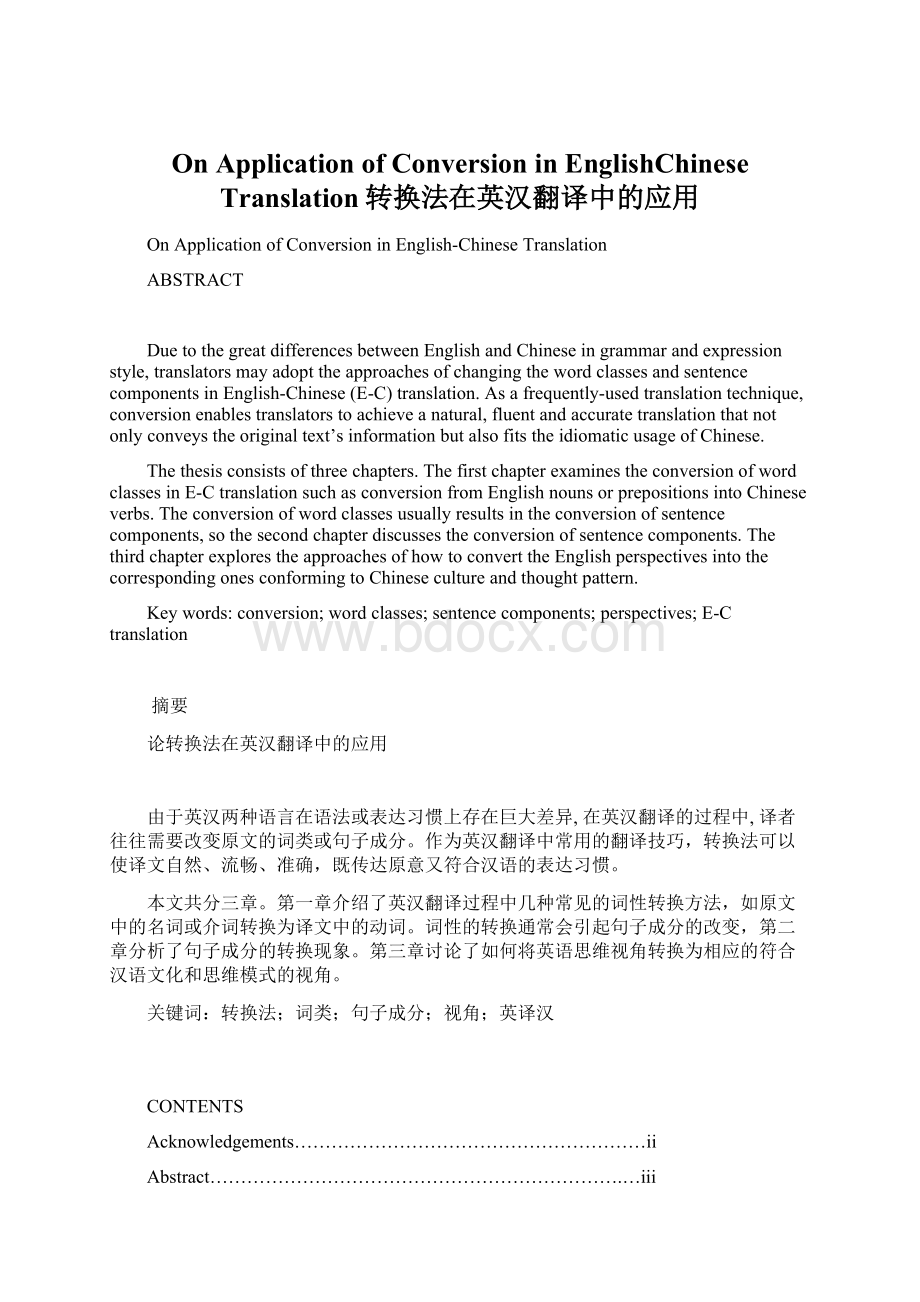 On Application of Conversion in EnglishChinese Translation转换法在英汉翻译中的应用Word文档格式.docx
On Application of Conversion in EnglishChinese Translation转换法在英汉翻译中的应用Word文档格式.docx
- 文档编号:21076537
- 上传时间:2023-01-27
- 格式:DOCX
- 页数:17
- 大小:39.26KB
On Application of Conversion in EnglishChinese Translation转换法在英汉翻译中的应用Word文档格式.docx
《On Application of Conversion in EnglishChinese Translation转换法在英汉翻译中的应用Word文档格式.docx》由会员分享,可在线阅读,更多相关《On Application of Conversion in EnglishChinese Translation转换法在英汉翻译中的应用Word文档格式.docx(17页珍藏版)》请在冰豆网上搜索。

sentencecomponents;
perspectives;
E-Ctranslation
摘要
论转换法在英汉翻译中的应用
由于英汉两种语言在语法或表达习惯上存在巨大差异,在英汉翻译的过程中,译者往往需要改变原文的词类或句子成分。
作为英汉翻译中常用的翻译技巧,转换法可以使译文自然、流畅、准确,既传达原意又符合汉语的表达习惯。
本文共分三章。
第一章介绍了英汉翻译过程中几种常见的词性转换方法,如原文中的名词或介词转换为译文中的动词。
词性的转换通常会引起句子成分的改变,第二章分析了句子成分的转换现象。
第三章讨论了如何将英语思维视角转换为相应的符合汉语文化和思维模式的视角。
关键词:
转换法;
词类;
句子成分;
视角;
英译汉
CONTENTS
Acknowledgements…………………………………………………ii
Abstract………………………………………………………….…iii
AbstractinChinese………………………………………………iv
Introduction…………………………………………………………1
ChapterOneConversionofWordClasses…………...…………3
I.ConversionintoChineseVerbs…………………………………3
II.ConversionintoChineseNouns………………………………5
.ConversionintoChineseAdjectives…………………………6
.ConversionintoChineseAdverbs……………………………7
ChapterTwoConversionofSentenceComponents…...………..9
I.ConversionintoChineseSubjects………………………………9
II.ConversionintoChinesePredicates…………………………10
.ConversionintoChineseObjects……………………………11
.ConversionintoChineseAttributes…………………………11
.ConversionintoChineseComplements…………………12
ChapterThreeConversionofPerspectives……………………14
I.ConversionofEnglishImpersonalSubjects…………………14
II.ConversionfromtheAbstractintotheConcrete…………….17
.ConversionfromtheStativeintotheDynamic………………17
.ConversionfromthePassiveintotheActive………………18
.ConversionbetweenNegativeandAffirmative………………18
Conclusion…………..……………………………….……………20
WorksCited……………………………………………………..…21
Introduction
Intranslationwemaygothroughmanyprocedurestotranslatethetexttomakeitacceptableforthespecificcommunicativesituation.Thetranslatingprocessisexplainedasfollows:
Translationisnotthetranscodingofwordsorsentencesfromonelanguagetoanother,butacomplexformofaction,wherebysomeoneprovidesinformationonatext(sourcelanguagematerial)inanewsituationandunderchangedfunctional,culturalandlinguisticconditions,preservingformalaspectsascloselyaspossible.(Snell-Hornby82)
Accordingtotheexplanation,intranslating,atranslator’staskistoconveythecontentandspiritofthesourcetextandrearrangethemintothetargettextinasmoothandlogicalwayunderthenewspecificsituationsandconditions.Additionally,weshouldrememberthat“anaturalstyleintranslatingisneverthelessessentialtoproducingintheultimatereceptorsaresponsesimilartothatoftheoriginalreceptors”(MaandMiao17).Therefore,effectivetranslationmethodsandtechniquesareundoubtedlyindispensableintranslatingactivities.
Conversion,asagrammaticalphenomenon,hasbeenahotsubjectinthefieldoflinguisticresearch.Sincesourcelanguageandtargetlanguagearequitedifferentinnatureanduse,andthetargettextshouldconveythemeaningofthesourcetextintheclosestnaturalmanner,conversionbecomesoneofthemosteffectivetechniquestoseekinthetargetlanguagetheequivalentinformationofthesourcelanguage.
Aclearandcorrectexpressionofthesourcetextiswhatreallymattersintranslation,foritiscrucialintranslationtoseekequivalenceincontentorinformation,butnotabsoluteformalcorrespondence.“Formostpeopletheinformativefunctionispredominantlythemajorroleoflanguage”(Hu10).Agoodtranslatorwillthereforeemployallpossiblemeanstoreproducethethoughtoftheauthorfaithfullyinanotherlanguage.“Conversionhaslongbeenacceptedasoneofthetechniquesessentialtoimprovingthequalityofourversion”(Zhong98),bywhichthemechanicaltranslationcouldbeavoided;
thereforeitenablestranslatorstoachieveanaturalandfaithfultranslationwhichnotonlyoffersinformationofthesourcetextbutalsokeepswiththeexpressionhabitsofthetargetlanguage.Inthisway,contentsofbothsourcelanguageandtargetlanguageareinaccordancewitheachother,thoughformsmaybesomewhatchanged.
Thethesisarguesthat,becauseofthegreatdifferencesbetweenEnglishandChineseingrammarandexpressionstyle,conversionbecomesafrequently-usedtranslationtechnique,whichenablestranslatorstoachieveanatural,fluentandaccuratetranslation.InadditiontoIntroductionandConclusion,thethesisconsistsofthreeparts.ThefirstchapterdiscussestheconversionofwordclassesinEnglish-Chinese(E-C)translation.Thesecondchapterfocusesontheconversionofsentencecomponents,whichisusuallycausedbytheconversionofwordclasses.ThethirdchapterexplorestheapproachesofhowtoconverttheEnglishperspectivesintothecorrespondingonesinChinese.
ChapterOne
ConversionofWordClasses
InE-Ctranslation,itisdifficulttogetanappropriatecorrespondingChinesewordforanEnglishwordofthesameclassallthetime.Ifeachwordinonelanguageisreplacedwithwordsofthesamewordclassesinanother,suchexpressionswouldsoundveryawkwardorevenunintelligibletothereader.Therefore,effectiveuseofwordclassconversioniscrucialandnecessaryinE-Ctranslation.
.ConversionintoChineseVerbs
BecauseoneofthemostremarkabledifferencesbetweenEnglishandChineseliesintheuseoftheverb,conversionintoChineseverbshasbecomethebasicconversiontechniqueusedinE-Ctranslation.
i.ConvertingEnglishNounintoChineseVerb
AsforEnglish,“itseemspossibletoexpressideaswithgreaterprecisionandadequacybymeansofnounsthanbymeansofthemorepictorialverbs”(Jespersen139).Thatistosay,“EnglishisalanguageinwhichnounsaremorewidelyusedthanthoseinChinese,whileinChineseverbsaremorefrequentlyusedandoccupyadominantposition”(Zhou391),thereforesomeEnglishnounsareoftenconvertedintoChineseverbsinthepracticaltranslation.
Specifically,anEnglishnounwhichpossessesthepropertyofaverborwasderivedfromaverbisoftenconvertedintoaverbwhentranslatedintoChinese.Hereisanexampletoillustratethispoint.
Example1:
Theuseofbacteriologicalweaponsisaclearviolationoftheinternationallaw.
使用细菌武器显然违反国际法。
ii.ConvertingEnglishPrepositionintoChineseVerb
Itisknownthat“thereareabout286prepositionsandprepositionalphrasesinEnglish”(Lian50).PrepositionsorprepositionalphrasesaresowidelyandfrequentlyusedinEnglishthatEnglishissometimescalledprepositionallanguage.PrepositionsinEnglish,whichareveryrichandflexibleinmeaning,haveagreatpowerofexpression;
onthecontrary,theChineselanguageisverb-oriented,soitisnotwithoutreasonthatEnglishprepositionsorprepositionalphrasesareoftenconvertedintoChineseverbsorverbalphrasesinE-Ctranslation.Thereisanexamplebelow.
Example2:
Itisourgoalthatthepeopleintheundevelopedareaswillbefinallyoffpoverty.
我们的目标是使不发达地区的人民最终摆脱贫困。
iii.ConvertingEnglishAdjectiveintoChineseVerb
WhenmeetingwithsuchEnglishadjectivesthatoftenindicatethehumanpsychologyorstateofmind,suchasone’sconsciousness,emotionalactivitiesanddesires,translatorsusuallyconvertthemintoChineseverbs.Hereisanexampletoillustratethepoint.
Example3:
Advancingintothevastnessofspace,manisbecomingfullyawareofthesmallnessofhisplanet.
由于进入浩无涯际的太空,人类已充分意识到本星球的渺小。
iv.ConvertingEnglishAdverbintoChineseVerb
SomeEnglishadverbs,whichhaveanimpliedmeaningofverbs,ifnecessary,areoftenconvertedintoChineseverbs.Thefollowingexampleillustratesthispoint.
Example4:
TheyfoundMr.Bennettstillup.
他们发现班纳特先生还没有睡觉。
v.ConvertingEnglishGerundintoChineseVerb
Gerund,alsocalledasaverbalnoun,oftenservesfunctionallyasanounbutretainssomepropertiesofaverbintheoriginaltext.However,thereisnosuchlinguisticformof-inginChinese,soEnglishgerundsaregenerallyconvertedintoChineseverbsinE-Ctranslation.Hereisanexample.
Example5:
Heatingwaterdoesnotchangeitschemicalcomposition.
把水加热不会改变水的化学成分。
.ConversionintoChineseNouns
NounsaccountforanoverwhelmingpartofthevocabularynotonlyinEnglishbutinChinese.SomeEnglishwords,forexample,whicharederivedfromnouns,canhardlybetranslatedliterally;
theyareusuallyconvertedintonouns.
i.ConvertingEnglishVerbintoChineseNoun
BecausesomeEnglishverbsdescribingthecharacteristicsorpropertiesofthesubjectaredifficulttoexpressinexactcorrespondingChineseverbs,theyareoftenconvertedintoChinesenounssoastoachieveasatisfactorytranslation.Hereisanillustrativeexample.
Example6:
Tothem,hepersonifiedtheabsolutepower.
在他们看来,他就是绝对权威的化身。
ii.ConvertingEnglishAdjectiveintoChineseNoun
SometimesEnglishadjectivesarealsoconvertedintoChinesenounsforthe
- 配套讲稿:
如PPT文件的首页显示word图标,表示该PPT已包含配套word讲稿。双击word图标可打开word文档。
- 特殊限制:
部分文档作品中含有的国旗、国徽等图片,仅作为作品整体效果示例展示,禁止商用。设计者仅对作品中独创性部分享有著作权。
- 关 键 词:
- On Application of Conversion in EnglishChinese Translation转换法在英汉翻译中的应用 Translation 转换法 英汉翻译 中的 应用
 冰豆网所有资源均是用户自行上传分享,仅供网友学习交流,未经上传用户书面授权,请勿作他用。
冰豆网所有资源均是用户自行上传分享,仅供网友学习交流,未经上传用户书面授权,请勿作他用。
链接地址:https://www.bdocx.com/doc/21076537.html


 对中国城市家庭的教育投资行为的理论和实证研究.docx
对中国城市家庭的教育投资行为的理论和实证研究.docx
